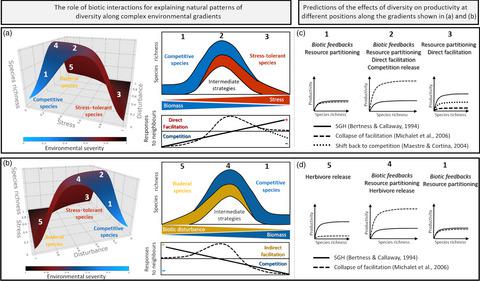Our official English website, www.x-mol.net, welcomes your
feedback! (Note: you will need to create a separate account there.)
Are complementarity effects of species richness on productivity the strongest in species‐rich communities?
Journal of Ecology ( IF 5.3 ) Pub Date : 2021-03-26 , DOI: 10.1111/1365-2745.13658 Richard Michalet 1 , Florian Delerue 2, 3 , Pierre Liancourt 4, 5 , Francisco I. Pugnaire 6
中文翻译:

在物种丰富的社区中,物种丰富度对生产力的互补效应是否最强?
更新日期:2021-05-12
Journal of Ecology ( IF 5.3 ) Pub Date : 2021-03-26 , DOI: 10.1111/1365-2745.13658 Richard Michalet 1 , Florian Delerue 2, 3 , Pierre Liancourt 4, 5 , Francisco I. Pugnaire 6
Affiliation

|
- How the relationship between species richness and productivity changes along environmental gradients remains poorly understood.
- We examined the context dependency of complementarity processes underpinning this relationship (biotic feedbacks, resource partitioning and facilitation) using the framework of Grime's (1973) humped‐back model. We considered several scenarios of variation in competition and facilitation along environmental gradients, either monotonic with the most common or intense facilitation at the most abiotically severe end of gradients or nonlinear with the strongest facilitation at intermediate positions along gradients.
- How competition shifts to facilitation along environmental gradients is a key for determining where the effect of species richness on productivity occurs. Based on the literature, the original Stress Gradient Hypothesis would likely predict that complementarity effects should be the greatest, or the most important, in the most abiotically stressful environments. Alternatively, both the ‘collapse of facilitation’ and the ‘shift back to competition’ scenarios predict that the highest overall complementary effects on productivity, not biomass, would most likely occur at intermediate positions along environmental stress gradients, but this might vary depending on the source of stress. This latter prediction is consistent with a great deal of literature on natural gradients of productivity and species richness.
- Synthesis. Our predictions illustrate the importance of better understanding the context dependency of complementarity processes and the key role of facilitation along environmental gradients to better focus conservation efforts where ecosystem functioning is more likely to be negatively affected by species loss, in particular in species‐rich communities.
中文翻译:

在物种丰富的社区中,物种丰富度对生产力的互补效应是否最强?
- 物种丰富度和生产力如何随环境梯度变化之间的关系仍然知之甚少。
- 我们使用Grime(1973)驼峰模型的框架研究了互补过程的语境依赖性,该过程支撑了这种关系(生物反馈,资源分配和促进)。我们考虑了几种竞争和促进作用随环境梯度变化的场景,要么是单调的,最常见的促进作用是最剧烈的,要么是梯度的非生物最严重末端的强烈促进作用,或者是沿着梯度的中间位置具有最强促进作用的非线性。
- 竞争如何沿着环境梯度转移到促进便利,是确定物种丰富度对生产力的影响发生在哪里的关键。根据文献,最初的应力梯度假说可能会预测,在非生物胁迫性环境中,互补效应应该是最大或最重要的。另外,“便利化的崩溃”和“转变为竞争”的情景都预示着,对生产力(而非生物质)的最高总体补充效应很可能发生在沿环境应力梯度的中间位置,但这可能会因环境的不同而有所不同。压力的来源。后一种预测与有关生产力和物种丰富度的自然梯度的大量文献一致。
- 综合。我们的预测表明了更好地理解互补过程的背景依赖性以及促进环境梯度变化的关键作用的重要性,以便更好地集中保护工作,其中生态系统功能更容易受到物种丧失的负面影响,特别是在物种丰富的社区。









































 京公网安备 11010802027423号
京公网安备 11010802027423号